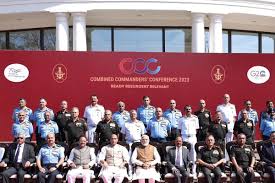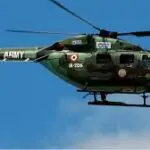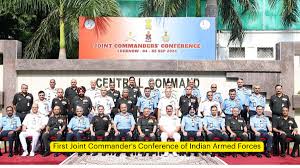First Joint Commanders’ Conference of Indian Armed Forces
Introduction: Overview of the Conference
The Indian Armed Forces held their inaugural Joint Commanders’ Conference on [Date], marking a significant milestone in the nation’s defense strategy. This landmark event brought together top military leaders from the Army, Navy, and Air Force to discuss and deliberate on critical defense matters. The conference, chaired by the Chief of Defence Staff (CDS), General Anil Chauhan, focused on enhancing inter-service cooperation and formulating strategic responses to emerging security challenges.
Objectives and Discussions
The primary objective of this conference was to streamline and synergize the operational strategies of the three armed services. The discussions revolved around several key areas, including joint operational planning, defense modernization, and resource allocation. The conference also aimed to address challenges related to cyber security, space operations, and counter-terrorism efforts. This collaborative approach is expected to enhance the efficiency and effectiveness of India’s defense mechanisms.
Significance of the Conference
The Joint Commanders’ Conference signifies a pivotal shift towards a more integrated defense structure. By fostering better coordination among the three services, the Indian Armed Forces are poised to address contemporary security threats more effectively. The conference underscores the importance of unity and strategic coherence in national defense, aligning with India’s broader goal of achieving a more formidable and responsive military force.
Future Prospects and Recommendations
Moving forward, the conference has set the stage for regular, high-level interactions among the top commanders. Recommendations from the conference include the establishment of a joint operational command center and enhanced joint training programs. These measures are designed to ensure that the Indian Armed Forces remain agile and prepared to tackle future security challenges with greater precision and coordination.

Why This News is Important
Enhancing Defense Coordination
The Joint Commanders’ Conference is a crucial step in improving the coordination among the Army, Navy, and Air Force. By bringing together the highest military officials, this initiative aims to eliminate operational silos and foster a unified defense strategy. This enhanced coordination is vital for responding to multi-dimensional threats and ensuring national security.
Strategic Integration for Improved Efficiency
The conference emphasizes the integration of various military branches, which is essential for streamlining defense operations. This strategic integration will help in optimizing resource utilization and operational efficiency, making the Indian Armed Forces more effective in executing complex missions.
Addressing Emerging Security Challenges
With the evolving nature of global security threats, the conference provides a platform for addressing contemporary challenges such as cyber warfare, space security, and counter-terrorism. By focusing on these areas, the Indian Armed Forces can better prepare for and mitigate potential risks.
Strengthening National Defense
The establishment of a joint command and regular high-level discussions among military leaders is expected to strengthen India’s national defense. This approach aligns with India’s vision of becoming a more formidable and responsive military power, capable of safeguarding its interests in an increasingly complex security environment.
Promoting Inter-Service Cooperation
The conference underscores the importance of inter-service cooperation in achieving a cohesive defense strategy. By fostering better collaboration between the Army, Navy, and Air Force, the Indian Armed Forces can ensure a more unified and effective defense posture.
Historical Context: Background Information
Historical Background
The concept of joint military conferences has been part of defense strategy discussions in various countries for years. In India, the need for such an integrated approach became more pronounced with the changing nature of warfare and security threats. Historically, the Indian Armed Forces have operated in a more segmented manner, with each branch focusing on its specific domain.
Previous Initiatives
Before this conference, India’s defense strategy involved separate discussions and planning sessions for each service. While these were effective to some extent, the lack of integration often led to inefficiencies and fragmented strategies. The establishment of the post of Chief of Defence Staff (CDS) was a significant step towards improving inter-service cooperation, paving the way for this landmark conference.
Current Context
In recent years, India has faced increasing security challenges, including regional conflicts, cyber threats, and global geopolitical shifts. The need for a cohesive and integrated approach to defense has become more critical, leading to the formulation of this joint commanders’ conference as a strategic initiative to address these evolving challenges effectively.
Key Takeaways from the First Joint Commanders’ Conference of Indian Armed Forces
| Serial Number | Key Takeaway |
|---|---|
| 1 | The conference marks the first-ever Joint Commanders’ Conference of the Indian Armed Forces. |
| 2 | It aims to enhance coordination and synergy among the Army, Navy, and Air Force. |
| 3 | Key discussion areas included joint operational planning, defense modernization, and cyber security. |
| 4 | Recommendations include the establishment of a joint operational command center and enhanced joint training programs. |
| 5 | The initiative reflects India’s commitment to a more integrated and effective defense strategy. |
Important FAQs for Students from this News
1. What was the primary objective of the first Joint Commanders’ Conference?
The primary objective was to enhance coordination and synergy among the Indian Army, Navy, and Air Force. The conference aimed to streamline defense strategies and improve inter-service collaboration.
2. Who chaired the first Joint Commanders’ Conference?
The conference was chaired by General Anil Chauhan, the Chief of Defence Staff (CDS) of India.
3. What were the main topics discussed at the conference?
The main topics included joint operational planning, defense modernization, cyber security, space operations, and counter-terrorism efforts.
4. What future steps are anticipated following the conference?
Future steps include establishing a joint operational command center and enhancing joint training programs to improve efficiency and effectiveness in defense operations.
5. How does the Joint Commanders’ Conference benefit India’s national defense?
The conference benefits national defense by promoting a more integrated and coordinated approach among the three services, improving response capabilities to multi-dimensional threats, and optimizing resource utilization.
Some Important Current Affairs Links


















